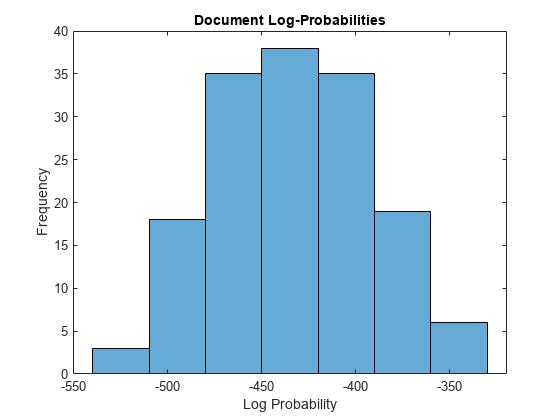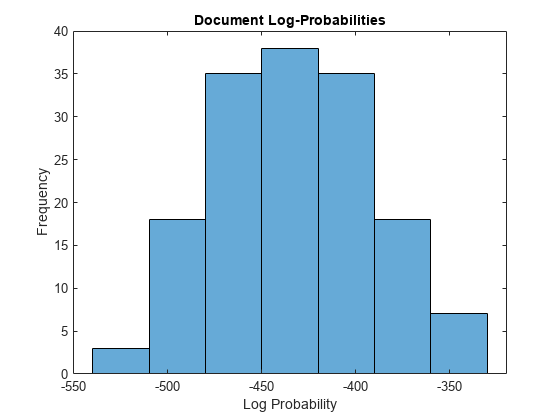logp
Document log-probabilities and goodness of fit of LDA model
Syntax
Description
___ = logp(___,
specifies additional options using one or more name-value pair arguments.Name,Value)
Examples
To reproduce the results in this example, set rng to 'default'.
rng('default')Load the example data. The file sonnetsPreprocessed.txt contains preprocessed versions of Shakespeare's sonnets. The file contains one sonnet per line, with words separated by a space. Extract the text from sonnetsPreprocessed.txt, split the text into documents at newline characters, and then tokenize the documents.
filename = "sonnetsPreprocessed.txt";
str = extractFileText(filename);
textData = split(str,newline);
documents = tokenizedDocument(textData);Create a bag-of-words model using bagOfWords.
bag = bagOfWords(documents)
bag =
bagOfWords with properties:
NumWords: 3092
Counts: [154×3092 double]
Vocabulary: ["fairest" "creatures" "desire" "increase" "thereby" "beautys" "rose" "might" "never" "die" "riper" "time" "decease" "tender" "heir" "bear" "memory" "thou" … ] (1×3092 string)
NumDocuments: 154
Fit an LDA model with 20 topics. To suppress verbose output, set 'Verbose' to 0.
numTopics = 20;
mdl = fitlda(bag,numTopics,'Verbose',0);Compute the document log-probabilities of the training documents and show them in a histogram.
logProbabilities = logp(mdl,documents); figure histogram(logProbabilities) xlabel("Log Probability") ylabel("Frequency") title("Document Log-Probabilities")

Identify the three documents with the lowest log-probability. A low log-probability may suggest that the document may be an outlier.
[~,idx] = sort(logProbabilities); idx(1:3)
ans = 3×1
146
19
65
documents(idx(1:3))
ans =
3×1 tokenizedDocument:
76 tokens: poor soul centre sinful earth sinful earth rebel powers array why dost thou pine suffer dearth painting thy outward walls costly gay why large cost short lease dost thou upon thy fading mansion spend shall worms inheritors excess eat up thy charge thy bodys end soul live thou upon thy servants loss let pine aggravate thy store buy terms divine selling hours dross fed rich shall thou feed death feeds men death once dead theres dying
76 tokens: devouring time blunt thou lions paws make earth devour own sweet brood pluck keen teeth fierce tigers jaws burn longlivd phoenix blood make glad sorry seasons thou fleets whateer thou wilt swiftfooted time wide world fading sweets forbid thee heinous crime o carve thy hours loves fair brow nor draw lines thine antique pen thy course untainted allow beautys pattern succeeding men yet thy worst old time despite thy wrong love shall verse ever live young
73 tokens: brass nor stone nor earth nor boundless sea sad mortality oersways power rage shall beauty hold plea whose action stronger flower o shall summers honey breath hold against wrackful siege battering days rocks impregnable stout nor gates steel strong time decays o fearful meditation alack shall times best jewel times chest lie hid strong hand hold swift foot back spoil beauty forbid o none unless miracle might black ink love still shine bright
Load the example data. sonnetsCounts.mat contains a matrix of word counts and a corresponding vocabulary of preprocessed versions of Shakespeare's sonnets.
load sonnetsCounts.mat
size(counts)ans = 1×2
154 3092
Fit an LDA model with 20 topics.
numTopics = 20; mdl = fitlda(counts,numTopics)
Initial topic assignments sampled in 0.030934 seconds. ===================================================================================== | Iteration | Time per | Relative | Training | Topic | Topic | | | iteration | change in | perplexity | concentration | concentration | | | (seconds) | log(L) | | | iterations | ===================================================================================== | 0 | 0.00 | | 1.159e+03 | 5.000 | 0 | | 1 | 0.02 | 5.4884e-02 | 8.028e+02 | 5.000 | 0 | | 2 | 0.02 | 4.7400e-03 | 7.778e+02 | 5.000 | 0 | | 3 | 0.02 | 3.4597e-03 | 7.602e+02 | 5.000 | 0 | | 4 | 0.03 | 3.4662e-03 | 7.430e+02 | 5.000 | 0 | | 5 | 0.03 | 2.9259e-03 | 7.288e+02 | 5.000 | 0 | | 6 | 0.03 | 6.4180e-05 | 7.291e+02 | 5.000 | 0 | =====================================================================================
mdl =
ldaModel with properties:
NumTopics: 20
WordConcentration: 1
TopicConcentration: 5
CorpusTopicProbabilities: [0.0500 0.0500 0.0500 0.0500 0.0500 0.0500 0.0500 0.0500 0.0500 0.0500 0.0500 0.0500 0.0500 0.0500 0.0500 0.0500 0.0500 0.0500 0.0500 0.0500]
DocumentTopicProbabilities: [154×20 double]
TopicWordProbabilities: [3092×20 double]
Vocabulary: ["1" "2" "3" "4" "5" "6" "7" "8" "9" "10" "11" "12" "13" "14" "15" "16" "17" "18" "19" "20" "21" "22" "23" "24" "25" "26" … ] (1×3092 string)
TopicOrder: 'initial-fit-probability'
FitInfo: [1×1 struct]
Compute the document log-probabilities of the training documents. Specify to draw 500 samples for each document.
numSamples = 500; logProbabilities = logp(mdl,counts, ... 'NumSamples',numSamples);
Show the document log-probabilities in a histogram.
figure histogram(logProbabilities) xlabel("Log Probability") ylabel("Frequency") title("Document Log-Probabilities")

Identify the indices of the three documents with the lowest log-probability.
[~,idx] = sort(logProbabilities); idx(1:3)
ans = 3×1
146
19
65
Compare the goodness of fit for two LDA models by calculating the perplexity of a held-out test set of documents.
To reproduce the results, set rng to 'default'.
rng('default')Load the example data. The file sonnetsPreprocessed.txt contains preprocessed versions of Shakespeare's sonnets. The file contains one sonnet per line, with words separated by a space. Extract the text from sonnetsPreprocessed.txt, split the text into documents at newline characters, and then tokenize the documents.
filename = "sonnetsPreprocessed.txt";
str = extractFileText(filename);
textData = split(str,newline);
documents = tokenizedDocument(textData);Set aside 10% of the documents at random for testing.
numDocuments = numel(documents);
cvp = cvpartition(numDocuments,'HoldOut',0.1);
documentsTrain = documents(cvp.training);
documentsTest = documents(cvp.test);Create a bag-of-words model from the training documents.
bag = bagOfWords(documentsTrain)
bag =
bagOfWords with properties:
NumWords: 2909
Counts: [139×2909 double]
Vocabulary: ["fairest" "creatures" "desire" "increase" "thereby" "beautys" "rose" "might" "never" "die" "riper" "time" "decease" "tender" "heir" "bear" "memory" "thou" … ] (1×2909 string)
NumDocuments: 139
Fit an LDA model with 20 topics to the bag-of-words model. To suppress verbose output, set 'Verbose' to 0.
numTopics = 20;
mdl1 = fitlda(bag,numTopics,'Verbose',0);View information about the model fit.
mdl1.FitInfo
ans = struct with fields:
TerminationCode: 1
TerminationStatus: "Relative tolerance on log-likelihood satisfied."
NumIterations: 26
NegativeLogLikelihood: 5.6915e+04
Perplexity: 742.7118
Solver: "cgs"
History: [1×1 struct]
Compute the perplexity of the held-out test set.
[~,ppl1] = logp(mdl1,documentsTest)
ppl1 = 781.6078
Fit an LDA model with 40 topics to the bag-of-words model.
numTopics = 40;
mdl2 = fitlda(bag,numTopics,'Verbose',0);View information about the model fit.
mdl2.FitInfo
ans = struct with fields:
TerminationCode: 1
TerminationStatus: "Relative tolerance on log-likelihood satisfied."
NumIterations: 37
NegativeLogLikelihood: 5.4466e+04
Perplexity: 558.8685
Solver: "cgs"
History: [1×1 struct]
Compute the perplexity of the held-out test set.
[~,ppl2] = logp(mdl2,documentsTest)
ppl2 = 808.6602
A lower perplexity suggests that the model may be better fit to the held-out test data.
Input Arguments
Input LDA model, specified as an ldaModel object.
Input documents, specified as a tokenizedDocument array, a string array of words, or a cell array of
character vectors. If documents is not a
tokenizedDocument array, then it must be a row vector representing
a single document, where each element is a word. To specify multiple documents, use a
tokenizedDocument array.
Input bag-of-words or bag-of-n-grams model, specified as a bagOfWords object or a bagOfNgrams object. If bag is a
bagOfNgrams object, then the function treats each n-gram as a
single word.
Frequency counts of words, specified as a matrix of nonnegative integers. If you specify
'DocumentsIn' to be 'rows', then the value
counts(i,j) corresponds to the number of times the
jth word of the vocabulary appears in the ith
document. Otherwise, the value counts(i,j) corresponds to the number
of times the ith word of the vocabulary appears in the
jth document.
Name-Value Arguments
Specify optional pairs of arguments as
Name1=Value1,...,NameN=ValueN, where Name is
the argument name and Value is the corresponding value.
Name-value arguments must appear after other arguments, but the order of the
pairs does not matter.
Before R2021a, use commas to separate each name and value, and enclose
Name in quotes.
Example: 'NumSamples',500 specifies to draw 500 samples for each
document
Orientation of documents in the word count matrix, specified as the comma-separated pair
consisting of 'DocumentsIn' and one of the following:
'rows'– Input is a matrix of word counts with rows corresponding to documents.'columns'– Input is a transposed matrix of word counts with columns corresponding to documents.
This option only applies if you specify the input documents as a matrix of word counts.
Note
If you orient your word count matrix so that documents correspond to columns and specify
'DocumentsIn','columns', then you might experience a significant
reduction in optimization-execution time.
Number of samples to draw for each document, specified as the
comma-separated pair consisting of 'NumSamples' and a
positive integer.
Example: 'NumSamples',500
Output Arguments
Log-probabilities of the documents under the LDA model, returned as a numeric vector.
Perplexity of the documents calculated from the log-probabilities, returned as a positive scalar.
Algorithms
The logp uses the iterated pseudo-count
method described in [1].
References
[1] Wallach, Hanna M., Iain Murray, Ruslan Salakhutdinov, and David Mimno. "Evaluation methods for topic models." In Proceedings of the 26th annual international conference on machine learning, pp. 1105–1112. ACM, 2009. Harvard
Version History
Introduced in R2017b
MATLAB Command
You clicked a link that corresponds to this MATLAB command:
Run the command by entering it in the MATLAB Command Window. Web browsers do not support MATLAB commands.
选择网站
选择网站以获取翻译的可用内容,以及查看当地活动和优惠。根据您的位置,我们建议您选择:。
您也可以从以下列表中选择网站:
如何获得最佳网站性能
选择中国网站(中文或英文)以获得最佳网站性能。其他 MathWorks 国家/地区网站并未针对您所在位置的访问进行优化。
美洲
- América Latina (Español)
- Canada (English)
- United States (English)
欧洲
- Belgium (English)
- Denmark (English)
- Deutschland (Deutsch)
- España (Español)
- Finland (English)
- France (Français)
- Ireland (English)
- Italia (Italiano)
- Luxembourg (English)
- Netherlands (English)
- Norway (English)
- Österreich (Deutsch)
- Portugal (English)
- Sweden (English)
- Switzerland
- United Kingdom (English)